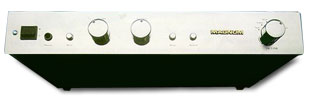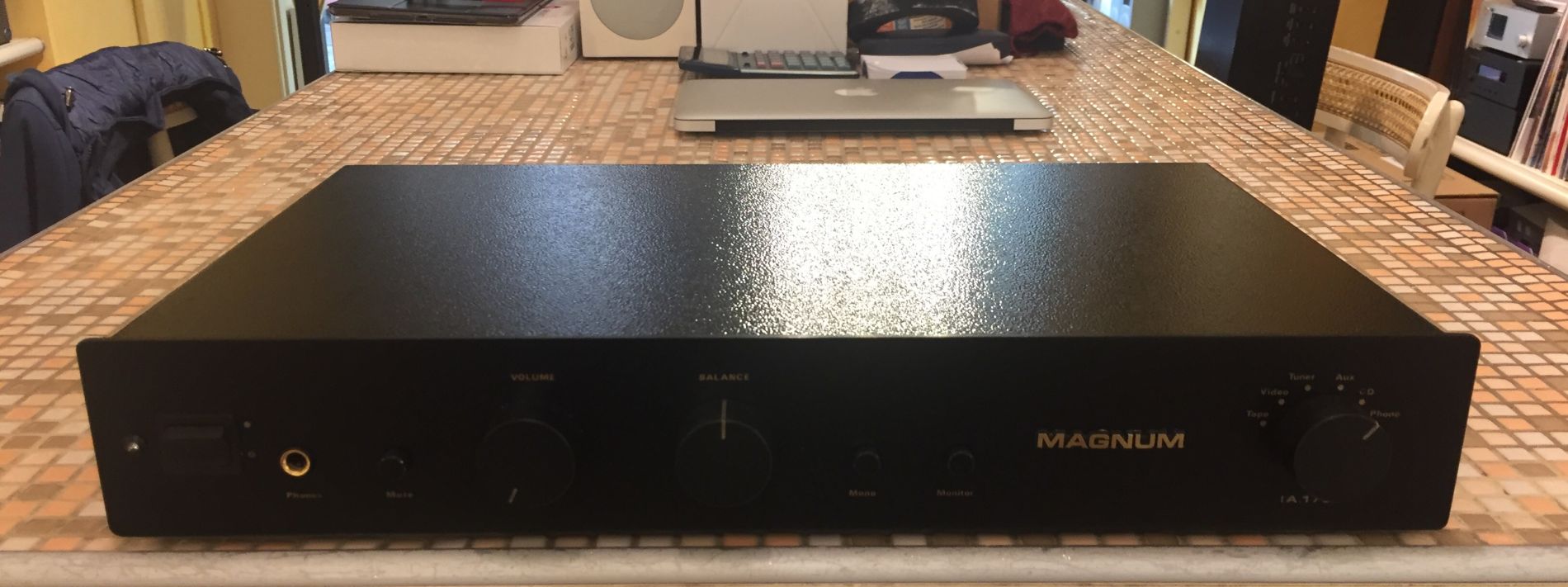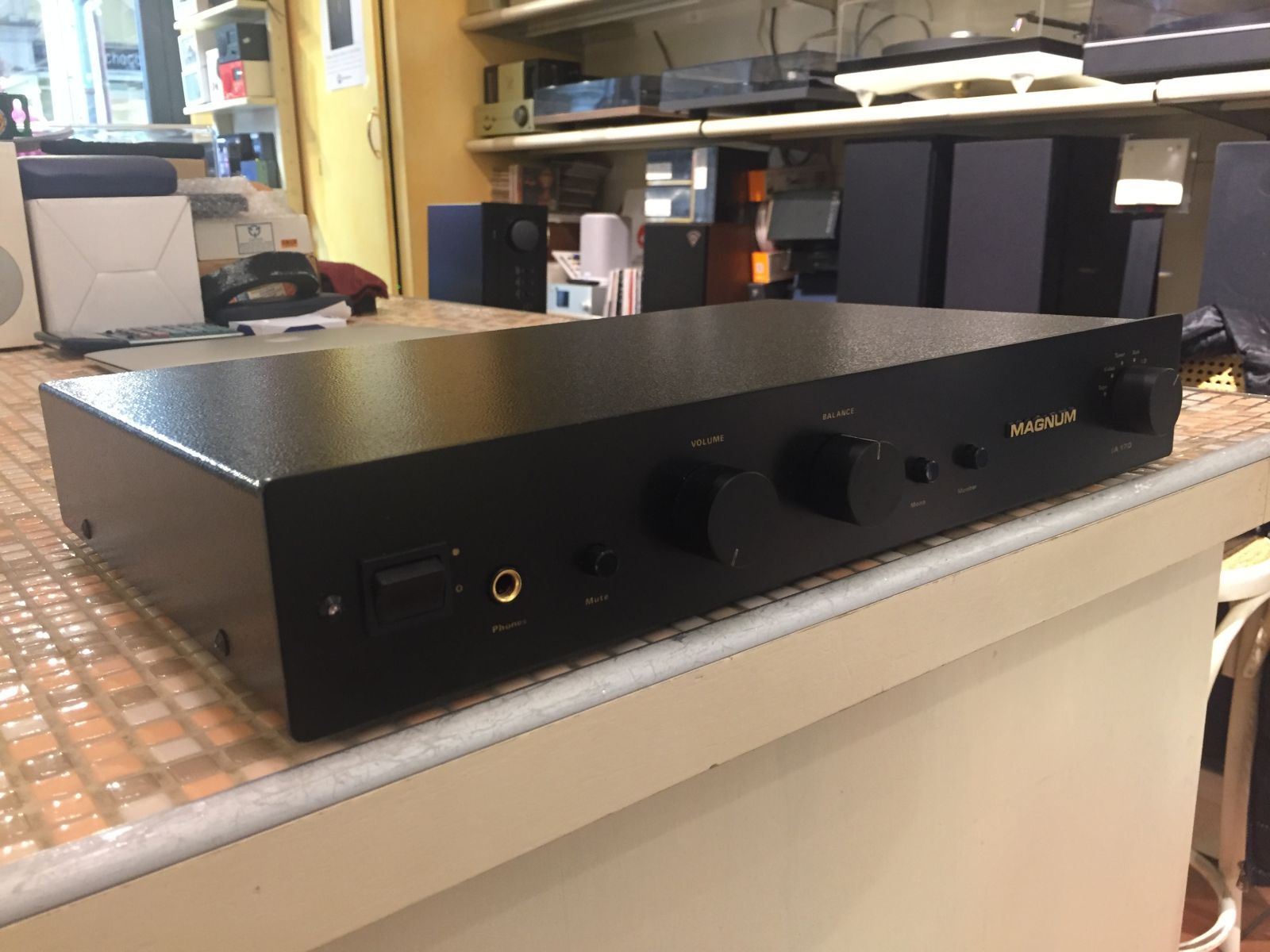
MAGNUM IA 170
€300,00
Magnum Audio IA 170 Integrated Amplifier
by Paul Schumann

|
|||||||||||||
Review Summary
|
It was accepted thinking not long ago that the only way to go high end was to buy a separate preamp and amplifier. This was especially true on this continent during the high-end industry’s "go-go" days; integrated amps were looked upon as somehow less than worthy. Even during this period, our friends over on the other side of the pond kept cranking out great little integrateds at reasonable prices. Now the pendulum of opinion has swung back here in the colonies. New integrated amps are popping up all over like dandelions in my yard in early spring. Leave it to the old masters to show us that they still have a few tricks up their sleeves when producing budget-priced integrated amplifiers. A case in point: the Magnum Audio IA 170 integrated amplifier.
For the past 12 years, I have been working in the environmental-consulting business. One of the terms we throw around quite a bit as consultants is "value added." This term means that if you are going to charge the same amount for the same job as the other guys, you need to make your customers feel like they’re getting a little more for their money. This might mean including color photographs of the site in the final report, or taking the time to sit down with a client to explain exactly what all the technical stuff you’ve produced really means. In summary, more bang for the buck.
So what does this have to do with a piece of audio equipment? The Magnum IA 170 is certainly a value-added component. The first thing that strikes you about the IA 170, at least the review sample sent to me, is its gleaming polished-steel faceplate and control knobs. That’s right, not brushed aluminum, but honest-to-God, shiny-like-the-chrome-bumper-of-a-‘57-Chevy polished steel. I’d never come across a chrome-like audio component before, but I have to admit that I like it. I know that some audio components are offered with this kind of finish at an extra cost, but with the Magnum IA 170, it comes standard (matte-black finish with gold lettering is available at a $75 charge). Included on the front panel are a rocker-type power switch, volume knob, selector knob, headphone jack, and push-button switches labeled mute, mono, and tape. All of the controls and switches have a reassuringly solid feel. The back is outfitted with two sets of speaker binding posts, six pairs of RCA-type inputs and one tape-loop output. Included with the line-stage inputs on the review unit is the optional phono stage, a $100 premium, that is factory set for moving-magnet cartridges. This phono stage can be modified to accept moving-coil cartridges by the dealer if need be.
Magnum Audio provides very little information on the design of the IA 170. The maximum output into 8 ohms is 70Wpc and into 4 ohms is 110Wpc. The signal-to-noise ratio is rated at -80dB through the line inputs and -70dB using the optional phono input. After that, Magnum is silent about the construction of the IA 170. Curious, I popped the top to sneak a peek. The interior of the Magnum is neatly laid out, with a toroidal power transformer to the left and four output transistors secured to the bottom of the chassis in the middle. A large circuit board takes up the right half and front. All of the controls, inputs, and output transistors are connected directly to the circuit board. This is obviously well-thought-out design.
Sound
Last year, Doug Blackburn wrote a column that changed the way I've been listening to audio equipment. At the heart of this column was the concept of balance. If you haven’t read the column yet, I urge you to check it out before you read the rest of this review. The overriding strength of the Magnum IA 170 is its balance. It really didn’t wow me right out of the box, but after several months of using it every day, I haven’t grown tired of it either. All the IA 170 does is play music, without beating you over the head with it. This truly can be a blessing.
|
An example of this balance is the overall tonal character of the Magnum. I’ve always been partial to using visual analogies with describing this characteristic. Overall, I’d describe the sound of IA 170 as slightly darker than real life -- a light to medium gray. This description is based mostly on the Magnum’s rendering of the treble frequencies. Strings, brass, and woodwinds don’t quite have the "air" of real things. This is not a dominating aspect, but it is noticeable. A good example of this is listening to the high-frequency laden album Balalaika Favorites [Classic/Mercury SR90310]. This recording, despite its age, is truly startling in its rendering of the massed strings of this uniquely Russian orchestra. While the highs may not sparkle, they certainly are never harsh or strident either. I definitely prefer the former to the latter.
The Magnum IA 170 shows good agility in the area of macrodynamics. Whenever I want to see how a product handles large-scale dynamics, I pull out one of my favorite torture test discs, Respigi’s Pines of Rome/Fountains of Rome [Sony SK 66843]. The closing movement to Pines of Rome is one long building crescendo, starting out at ppp and ending with a rousing fff. Only when turned up to a realistic volume, once the orchestra hits forte, the soundstage begins to collapse and a slight muddiness becomes apparent. Despite this, the Magnum IA 170 never adds hardness to sound when pushed to extremes. This forgiving nature helps make this a listenable amplifier even operated outside its comfort zone.
One of the features of the IA 170 that I want to focus on is the ability to switch from stereo to mono. Back in the early days of stereo, all of the systems had means to do this because everyone had a bunch of mono records in their collection. Now the presence of a mono switch is a rarity. This is unfortunate since there is still a great deal of music being re-released these days that was originally recorded in mono. Unless you have a dedicated mono system (I have a friend who actually does), you can’t listen to a mono recording properly on a stereo system without a mono switch. By combining the signals from both channels, phase anomalies between them are eliminated, thereby improving the sound. This was quite evident while I listened to the Karajan/VPO classic recording of Humperdink’s Hansel and Gretel [Angel 3506 B]. With the switch in the normal stereo setting, I thought everything sounded fine, with unfamiliar bunched-in-the-middle soundstage. When I engaged the mono switch, the feeling of space between and behind the speakers was enhanced considerably. In addition, bass was better defined, and vocal intelligibility improved greatly. Overall, I enjoyed this album more than ever.
As I mentioned earlier in the review, the Magnum IA 170 can come with an optional phono stage, which my review unit had. During the first stage of this review, I used my familiar Creek OBH-8 for my phono stage. This way I could develop a good feel of the sound of the IA 170 without adding its phono stage to the mix. Once I felt comfortable with the Magnum, the switch was made. After a few days of break-in, I started to compile notes on the IA 170's phono stage. Overall, it compared very favorably with the Creek unit. While listening to Pierre Monteux’s and the LSO’s recording of Stravinsky’s Petrushka [RCA LSC-2376], I was able to discern a few differences, however. Strings with the Magnum had a bit more edge to them and some of the inner detail was lost. I also noticed a bit of compression on some of the shuddering crescendos in this piece. In all honesty, there was a lot more in common between the Creek and Magnum phono stages. Since both are British products, I’ll just chalk it up to shared sensibilities between two manufacturers.
Comparison and conclusion
OK, now it’s comparison time. I’ve had two other solid-state integrateds in my system lately: the Anthem Integrated 2 and the Simaudio Celeste I-5080. Priced at $1080 and $1199 USD respectively, they are both more expensive than the Magnum IA 170. The Anthem Integrated 2 is real powerhouse of an integrated, and this is where it clearly betters the Magnum and Simaudio units. While the Magnum can be pushed on the big crescendos, the Anthem never broke a sweat. The I-5080’s forte is its remarkable transparency, stripping bare the recording, warts and all. If it is resolution in an integrated you want, the Celeste is the ticket. In contrast, while the Magnum may not strip a recording bare, it keeps many lesser recordings sounding enjoyable.
The other integrated I used for comparison is my own Jolida SJ202A. The Jolida is priced about the same as the IA 170, but it's a tubed unit. While the Magnum is more powerful and laden with many more features, the Jolida does have that undeniable tube sound. Hey, I never said that you could have it all in this price range!
No matter how much I’ve listened to the Magnum, I still keep coming back to its balance. Sure it doesn’t let you hear the creaking spine of the elderly cello player in the second row, but you’ll never have to duck for cover as a razor-sharp transient wave comes ripping for your head. While it will never shake the plaster from the ceiling, you certainly never feel inhibited to get up and shake yer booty when the mood arises.
Like another great British product, the MGB, the IA 170 just shouldn’t be as good as it is. I dare anyone to find an integrated amp in the Magnum IA 170’s price range that is its equal in both sound and features. Its great-sounding optional phono stage will make it easy for you to discover (or rediscover) the joys of vinyl. This chrome beauty is a natural for anyone looking for an integrated that is a cut above the mass-market boxes, without breaking the bank.

Ops!
Sembra che la versione di questo browser non sia supportata.
Puoi provare con uno dei seguenti browser

Chrome

Firefox

Edge

Safari

Opera








